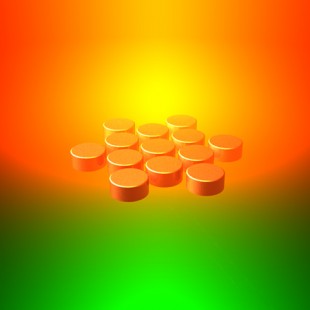May 22 2013
Rice University scientists have unveiled a robust new method for arranging metal nanoparticles in geometric patterns that can act as optical processors that transform incoming light signals into output of a different color. The breakthrough by a team of theoretical and applied physicists and engineers at Rice’s Laboratory for Nanophotonics (LANP) is described this week in the Proceedings of the National Academy of Sciences.
 Physicists and engineers from Rice's Laboratory for Nanophotonics have unveiled a robust new method for arranging metal nanoparticles in geometric patterns that can act as optical processors that transform incoming light signals into output of a different color. CREDIT: Yu Zhang/Rice University
Physicists and engineers from Rice's Laboratory for Nanophotonics have unveiled a robust new method for arranging metal nanoparticles in geometric patterns that can act as optical processors that transform incoming light signals into output of a different color. CREDIT: Yu Zhang/Rice University
Rice’s team used the method to create an optical device in which incoming light could be directly controlled with light via a process known as “four-wave mixing.” Four-wave mixing has been widely studied, but Rice’s disc-patterning method is the first that can produce materials that are tailored to perform four-wave mixing with a wide range of colored inputs and outputs.
“Versatility is one of the advantages of this process,” said study co-author Naomi Halas, director of LANP and Rice’s Stanley C. Moore Professor in Electrical and Computer Engineering and a professor of biomedical engineering, chemistry, physics and astronomy. “It allows us to mix colors in a very general way. That means not only can we send in beams of two different colors and get out a third color, but we can fine-tune the arrangements to create devices that are tailored to accept or produce a broad spectrum of colors.”
The information processing that takes place inside today’s computers, smartphones and tablets is electronic. Each of the billions of transistors in a computer chip uses electrical inputs to act upon and modify the electrical signals passing through it. Processing information with light instead of electricity could allow for computers that are both faster and more energy-efficient, but building an optical computer is complicated by the quantum rules that light obeys.
“In most circumstances, one beam of light won’t interact with another,” said LANP theoretical physicist Peter Nordlander, a co-author of the new study. “For instance, if you shine a flashlight at a wall and you cross that beam with the beam from a second flashlight, it won’t matter. The light that comes out of the first flashlight will pass through, independent of the light from the second.
“This changes if the light is traveling in a ‘nonlinear medium,’” he said. “The electromagnetic properties of a nonlinear medium are such that the light from one beam will interact with another. So, if you shine the two flashlights through a nonlinear medium, the intensity of the beam from the first flashlight will be reduced proportionally to the intensity of the second beam.”
The patterns of metal discs LANP scientists created for the PNAS study are a type of nonlinear media. The team used electron-beam lithography to etch puck-shaped gold discs that were placed on a transparent surface for optical testing. The diameter of each disc was about one-thousandth the width of a human hair. Each was designed to harvest the energy from a particular frequency of light; by arranging a dozen of the discs in a closely spaced pattern, the team was able to enhance the nonlinear properties of the system by creating intense electrical fields.
“Our system exploits a particular plasmonic effect called a Fano resonance to boost the efficiency of the relatively weak nonlinear effect that underlies four-wave mixing,” Nordlander said. “The result is a boost in the intensity of the third color of light that the device produces.”
Graduate student and co-author Yu-Rong Zhen calculated the precise arrangement of 12 discs that would be required to produce two coherent Fano resonances in a single device, and graduate student and lead co-author Yu Zhang created the device that produced the four-wave mixing — the first such material ever created.
“The device Zhang created for four-wave mixing is the most efficient yet produced for that purpose, but the value of this research goes beyond the design for this particular device,” said Halas, who was recently named a member of the National Academy of Sciences for her pioneering research in nanophotonics. “The methods used to create this device can be applied to the production of a wide range of nonlinear media, each with tailored optical properties.”